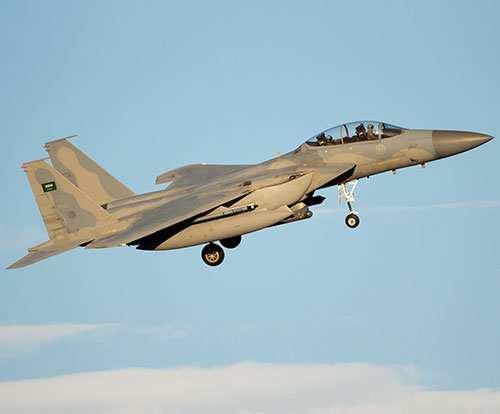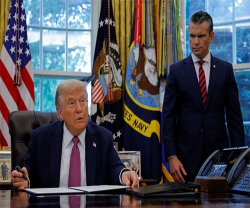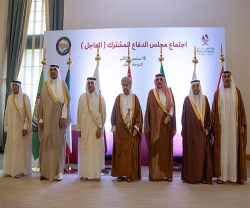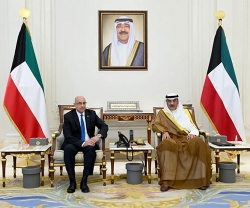International transfers of major arms during the five-year period 2015-2019 increased by 5.5% compared with 2010-2014. According to new data published Monday by the Stockholm International Peace Research Institute (SIPRI), the largest exporters of arms during the past five years were the United States, Russia, France, Germany and China.
The new data shows that the flow of arms to the Middle East has increased, with Saudi Arabia clearly being the world’s largest importer.
Significant Increase in Arms Exports from the United States and France
Between 2010-2014 and 2015-2019, exports of major arms from the USA grew by 23%, raising its share of total global arms exports to 36%. In 2015-2019 total US arms exports were 76% higher than those of the second-largest arms exporter in the world, Russia. Major arms transferred from the USA went to a total of 96 countries.
“Half of US arms exports in the past five years went to the Middle East, and half of those went to Saudi Arabia,” said Pieter D. Wezeman, Senior Researcher at SIPRI. “At the same time, demand for the USA’s advanced military aircraft increased, particularly in Europe, Australia, Japan and Taiwan,” he added.
French arms exports reached their highest level for any five-year period since 1990 and accounted for 7.9% of total global arms exports in 2015-2019, a 72% increase on 2010-2014. ‘The French arms industry has benefited from the demand for arms in Egypt, Qatar and India,” said Diego Lopes Da Silva, SIPRI Researcher.
Notable Decrease in Russian Arms Exports
Major arms exports by Russia decreased by 18% between 2010-2014 and 2015-2019. “Russia has lost traction in India - the main long-term recipient of Russian major arms - which has led to a sharp reduction in arms exports. This decrease was not offset by the increase in Russian arms exports to Egypt and Iraq in 2015-2019,” said Alexandra Kuimova, SIPRI Researcher.
Arms Flows to Countries in Conflict
Arms imports by countries in the Middle East increased by 61% between 2010-2014 and 2015-2019, and accounted for 35% of total global arms imports over the past five years.
Saudi Arabia was the world’s largest arms importer in 2015-2019. Its imports of major arms increased by 130% compared with the previous five-year period and it accounted for 12% of global arms imports in 2015-2019. Despite the wide-ranging concerns in the USA and the United Kingdom about Saudi Arabia’s military intervention in Yemen, both the USA and the UK continued to export arms to Saudi Arabia in 2015-2019. A total of 73% of Saudi Arabia’s arms imports came from the USA and 13% from the UK.
India was the second-largest arms importer in the world over the past five years, with its neighbour Pakistan ranking 11th.
The United Arab Emirates (UAE) has been militarily involved in Libya as well as Yemen over the past five years and was the 8th-largest arms importer in the world in 2015-2019. Two-thirds of its arms imports came from the USA during this period. In 2019, when foreign military involvement in Libya was condemned by the United Nations Security Council, the UAE had major arms import deals ongoing with Australia, Brazil, Canada, China, France, Russia, South Africa, Spain, Sweden, Turkey, the UK and the USA.
In 2015-2019 there were again armed clashes between Armenia and Azerbaijan. Both countries are building up their military capability through imports, including missiles capable of attacking targets inside each other’s territory. Russia accounted for almost all of Armenia’s arms imports over the past five years. A total of 60% of Azerbaijan’s arms imports came from Israel and 31% from Russia.
In 2015-2019 Turkish arms imports were 48% lower than in the previous five-year period, even though its military was fighting Kurdish rebels and was involved in the conflicts in Libya and Syria. This decrease in imports can be explained by delays in deliveries of some major arms, the cancellation of a large deal with the USA for combat aircraft, and developments in the capability of the Turkish arms industry.
Other Notable Developments
- Germany’s arms exports were 17% higher in 2015-2019 than in 2010-2014
- China was the fifth-largest arms exporter in 2015-2019 and significantly increased the number of recipients of its major arms: from 40 in 2010-2014 to 53 in 2015-2019
- South Korea’s arms exports rose by 143% between 2010-2014 and 2015-2019 and it entered the list of the top 10 largest exporters for the first time
- Israeli arms exports increased by 77% between 2010-2014 and 2015-2019 to their highest-ever level
- West and Central European states had outstanding orders at the end of 2019 for imports of 380 new combat aircraft from the USA
- Egypt’s arms imports tripled between 2010-2014 and 2015-2019, making it the world’s third-largest arms importer
- Brazil’s arms imports in 2015-2019 were the highest in South America, accounting for 31% of the sub region’s arms imports, despite a 37% decrease compared with 2010-2014
- South Africa, the largest arms importer in sub-Saharan Africa in 2005-2009, imported almost no major arms in 2015-2019





















